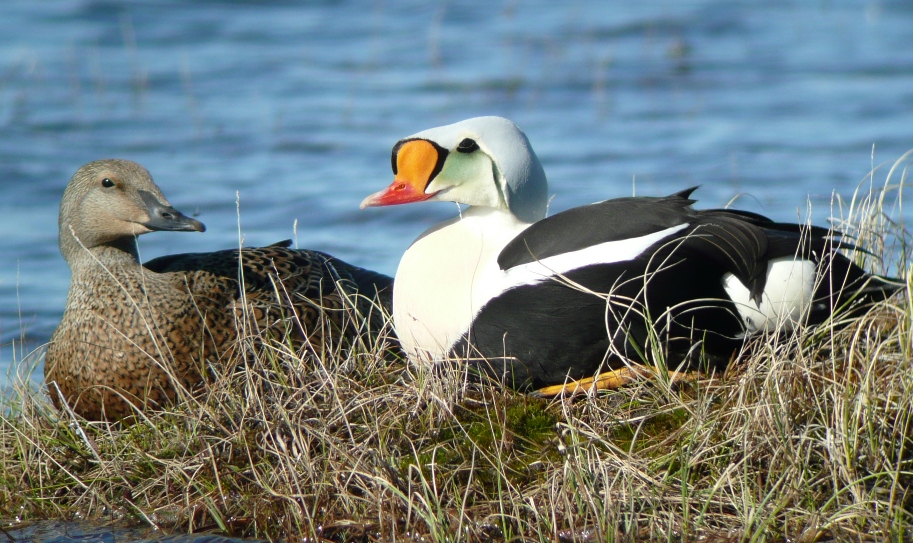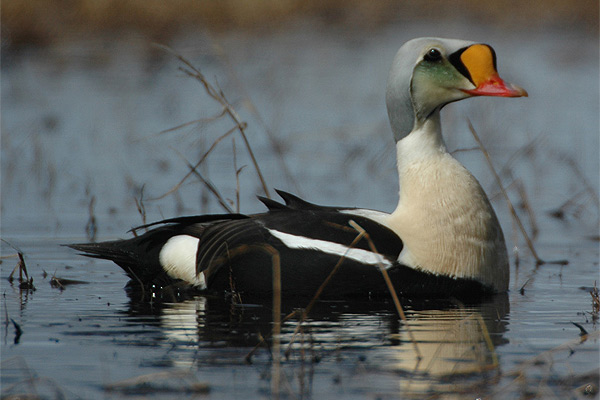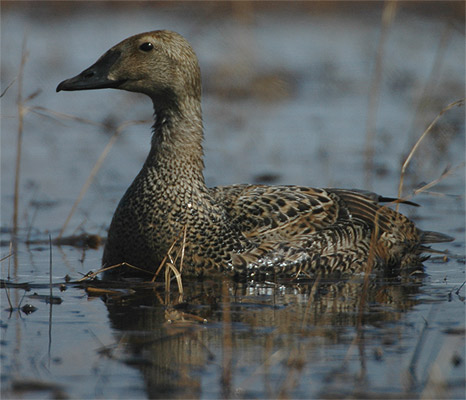INTRODUCTION
 King Eiders (Somateria spectabilis) are large
sea ducks that breed at high latitudes across the arctic tundra and winter at
sea along the southern extent of the pack ice. Sea ducks include species such as Common Eiders,
Spectacled Eiders, Surf Scoters, White-winged Scoters, Harlequin Ducks, Common
Mergansers, Long-tailed Ducks and Buffleheads. All of these birds spend a large proportion of their annual life cycle at sea. For more information on sea
ducks visit the Sea Duck Joint
Venture web site. For a detailed account on the biology of King Eiders visit the Birds of North America online.
King Eiders (Somateria spectabilis) are large
sea ducks that breed at high latitudes across the arctic tundra and winter at
sea along the southern extent of the pack ice. Sea ducks include species such as Common Eiders,
Spectacled Eiders, Surf Scoters, White-winged Scoters, Harlequin Ducks, Common
Mergansers, Long-tailed Ducks and Buffleheads. All of these birds spend a large proportion of their annual life cycle at sea. For more information on sea
ducks visit the Sea Duck Joint
Venture web site. For a detailed account on the biology of King Eiders visit the Birds of North America online.
King Eider populations have decreased by over 50% across the
western Canadian and eastern Alaskan portion of their range between the 1970s and the 1990s. This
decline reflects that of other sea ducks across the globe. Although the western North American King Eider population appears to be stable right now, the causes for the earlier declines are still poorly understood.
This study is a joint effort between the University of
Alaska Fairbanks, government agencies, local community governments, and
industry to examine the migration ecology and breeding biology of King Eiders
nesting in northern Alaska. We specifically attempt to elucidate the connections between different stages of the annual cycle of King Eiders to determine possible causes for population declines.
To follow King Eiders through migration, we
surgically implanted satellite transmitters (PTTs - Platform Transmitting
Terminals) into eiders captured on their breeding grounds in northern Alaska. Data from these transmitters allow us to determine timing and
location of migration routes, molting sites, and wintering areas used by King
Eiders nesting in Alaska.
King Eiders spend most of the year at sea where they feed on marine invertebrates. They obtain their prey by diving to the sea bed - often more than 40m deep on the ocean floor! Since the birds are exposed to extreme temperatures and weather conditions during winter, they have to migrate to areas that offer them an abundance of prey. If conditions in a wintering area are poor the ducks may emerge from winter in a poor body condition which could affect their breeding performance in the subsequent summer. In this project we examined seasonal interactions between winter and summer, and between spring migration and the breeding season, to explore how habitat changes of wintering or spring staging areas would affect reproductive output of King Eiders in northern Alaska.
[back to King Eider main page]
 King Eiders (Somateria spectabilis) are large
sea ducks that breed at high latitudes across the arctic tundra and winter at
sea along the southern extent of the pack ice. Sea ducks include species such as Common Eiders,
Spectacled Eiders, Surf Scoters, White-winged Scoters, Harlequin Ducks, Common
Mergansers, Long-tailed Ducks and Buffleheads. All of these birds spend a large proportion of their annual life cycle at sea. For more information on sea
ducks visit the Sea Duck Joint
Venture web site. For a detailed account on the biology of King Eiders visit the Birds of North America online.
King Eiders (Somateria spectabilis) are large
sea ducks that breed at high latitudes across the arctic tundra and winter at
sea along the southern extent of the pack ice. Sea ducks include species such as Common Eiders,
Spectacled Eiders, Surf Scoters, White-winged Scoters, Harlequin Ducks, Common
Mergansers, Long-tailed Ducks and Buffleheads. All of these birds spend a large proportion of their annual life cycle at sea. For more information on sea
ducks visit the Sea Duck Joint
Venture web site. For a detailed account on the biology of King Eiders visit the Birds of North America online.
